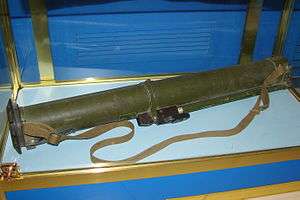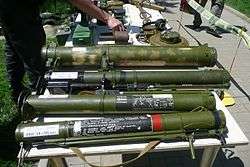RPG-26
The RPG-26 Aglen is a disposable anti-tank rocket launcher developed by the Soviet Union. It fires a single-stage rocket with jack-knife fins, which unfold after launch. The rocket carries a 72.5 millimeter diameter high explosive anti-tank single shaped charge warhead capable of penetrating 440 millimeters of armour, one meter of reinforced concrete or one and a half meters of brickwork. It has a maximum effective range of around 250 meters. The RPG-26 is a product improved version of the RPG-22. The similar sized rocket features a slightly heavier and more powerful HEAT warhead and more powerful rocket engine. The limited extension of the RPG-22 launch tube was found of little use. Therefore the RPG-26 has a rigid non-telescoping launch tube.The RPG-26 and its variants are actively used by Russian forces. It has been exported to several nations and is actively marketed for export. The more specialized variants are in Russian service and available for export as well.
| RPG-26 | |
|---|---|
 An RPG-26 in a museum | |
| Type | Disposable Anti-tank rocket launcher |
| Place of origin | Soviet Union |
| Service history | |
| In service | 1985–present |
| Used by | Russian Ground Forces |
| Wars | Syrian Civil War War in Donbass |
| Production history | |
| Designer | State Research and Production Enterprise, Bazalt |
| Designed | 1980s |
| Manufacturer | State Research and Production Enterprise, Bazalt |
| Produced | 1985 - present |
| Variants | RShG-2 |
| Specifications | |
| Mass | 1.8 kilograms (4.0 lb) (projectile) 2.9 kilograms (6.4 lb) (loaded) |
| Length | 77 centimetres (30 in) |
| Caliber | 72.5 mm |
| Action | 440 mm: RHA at 60° impact angle 1000 mm: Reinforced concrete 1500 mm: Brickwork 2400 mm: Log and earth |
| Muzzle velocity | 144 m/s |
| Effective firing range | 250 m |
| Sights | Iron sights |
Variants
RShG-2
The RShG-2 (Russian: Реактивная Штурмовая Граната, Reaktivnaya Shturmovaya Granata, Rocket-propelled Assault Grenade ) Aglen-2 (Аглень-2) is a RPG-26 variant with thermobaric warhead. RShG-2 is heavier than the RPG-26 at 3.5 kilograms, and has a reduced direct fire range of 115 meters. It is intended to be used against infantry and structures rather than armored vehicles. The warhead contains 1.16 kilograms of thermobaric mixture, with an explosive yield roughly equal to that of 3 kilograms of TNT. The solid rocket booster of the warhead in question was taken from the RPG-26 and the fuse taken from the TBG-7 warhead used by the RPG-7. The warhead has a stated penetration capability of 300 millimeters of concrete and 500 millimeters of brickwork.
Specifications

- Calibre: 72.5 mm
- Length: 770 mm
- Weight: 2.9 kg
- Range: effective combat, 250 m
- Operating temperature: -50 to +50°C
- RHA penetration: 440 mm at 60°
Operators
Current operators
Former operators
References
- "Российское оружие в Армении" [Russian weapons in Armenia]. Nvo.ng.ru (in Russian). 10 August 2018.
- "SDC Delta : Small Arms" (PDF). Delta.gov.ge. Retrieved 19 February 2019.
- "Archived copy". Archived from the original on 2017-12-29. Retrieved 2017-12-29.CS1 maint: archived copy as title (link)
- Ferguson, Jonathan; Jenzen-Jones, N.R. (November 2014). Raising Red Flags: An Examination of Arms & Munitions in the Ongoing Conflict in Ukraine, 2014 (PDF). Research Report 3. Armament Research Services. pp. 26, 48. ISBN 978-0-9924624-3-7.
- Toumaj, Amir (October 14, 2016). "Russian influence evident in Palestinian militia in Syria". Long War Journal. Retrieved 28 November 2016.
External links
| Wikimedia Commons has media related to RPG-26. |
- RPG-26 "Aglen"
- Modern Firearms
- "Средства ближнего боя : Открытое акционерное общество «Научно-производственное обьединение «Базальт»". Bazalt.ru. Retrieved 19 February 2019.
- RPG-26